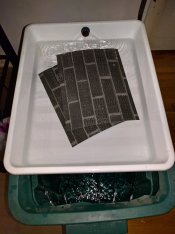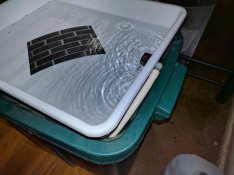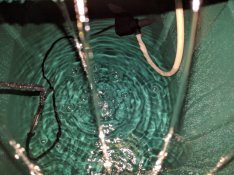ratmandu
Member
- Joined
- Nov 1, 2015
- Messages
- 8
- Format
- Multi Format
I've been setting up a darkroom in a weird attic space in my new home. This room does not have running water or drainage, so any water that comes in or goes out, goes in buckets.
I've been thinking of a way to wash my prints in this space. I had a wash tray that was supposed to be hooked up to a faucet, as well as a large rubbermaid tub (used for storing assorted stuff, this one had christmas decorations in it). I cut a hole in one side of the lid, for water to drain back down into the bucket from the tray, as well as a small hole for the water line to the tray.
I hooked the water line to a small submersible pump that i've had for circulating water in a tempering bath for C-41 dev (was purchased at walmart in the pet section). The pump has enough power to push the water up to the tray (look for HMax on the pump), and enough flow to fill the tray up to the second set of holes in the end of the tray, and stay there.
I've filled the tub with about 8 gallons of water (I've got two 5 gallon buckets that I fill with about 4 gallons so I don't slosh water all up and down the hallway). After 10 prints or so, I replace about half the water using a secondary pump which is a bit more powerful and much faster than the first.
Before putting a print in the washer, I have a tray holding about a gallon of water that I rinse with first, to get most of the most concentrated fixer out. When I replace the water in the tub, I replace the water in the rinse tray with some of the water in the tub.
I haven't had a chance to run a test to make sure the residual fixer is gone yet, but I will do that soon. If anyone has any thoughts or opinions, or any suggestions on improvements, let me know. In the mean time, I wanted to share this with anyone else who might not have running water in their darkroom, and has about $15 to spend on a part washer.
Anyway, here's some pictures



I've been thinking of a way to wash my prints in this space. I had a wash tray that was supposed to be hooked up to a faucet, as well as a large rubbermaid tub (used for storing assorted stuff, this one had christmas decorations in it). I cut a hole in one side of the lid, for water to drain back down into the bucket from the tray, as well as a small hole for the water line to the tray.
I hooked the water line to a small submersible pump that i've had for circulating water in a tempering bath for C-41 dev (was purchased at walmart in the pet section). The pump has enough power to push the water up to the tray (look for HMax on the pump), and enough flow to fill the tray up to the second set of holes in the end of the tray, and stay there.
I've filled the tub with about 8 gallons of water (I've got two 5 gallon buckets that I fill with about 4 gallons so I don't slosh water all up and down the hallway). After 10 prints or so, I replace about half the water using a secondary pump which is a bit more powerful and much faster than the first.
Before putting a print in the washer, I have a tray holding about a gallon of water that I rinse with first, to get most of the most concentrated fixer out. When I replace the water in the tub, I replace the water in the rinse tray with some of the water in the tub.
I haven't had a chance to run a test to make sure the residual fixer is gone yet, but I will do that soon. If anyone has any thoughts or opinions, or any suggestions on improvements, let me know. In the mean time, I wanted to share this with anyone else who might not have running water in their darkroom, and has about $15 to spend on a part washer.
Anyway, here's some pictures



















